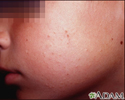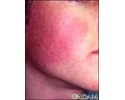Keratosis pilaris
Keratosis pilaris is a common skin condition in which a protein in the skin called keratin forms hard plugs within hair follicles.
Keratosis pilaris is harmless (benign). It seems to run in families. It is more common in people who have very dry skin, or who have atopic dermatitis (eczema).
The condition is generally worse in winter and often clears in the summer.
Symptoms
Symptoms may include:
- Small bumps that look like "goose bumps" on the back of the upper arms and thighs
- Bumps feel like very rough sandpaper
- Skin-colored bumps are the size of a grain of sand
- Slight pinkness may be seen around some bumps
- Bumps may appear on the face and be mistaken for acne
Exams and Tests
Your health care provider can usually diagnose this condition by looking at your skin. Tests are often not needed.
Treatment
Treatment may include:
- Moisturizing lotions to soothe the skin and help it look better
- Skin creams that contain urea, lactic acid, glycolic acid, salicylic acid, tretinoin, or vitamin D
- Steroid creams to reduce redness
Improvement often takes months, and the bumps are likely to come back if you stop using the medicine.
Outlook (Prognosis)
Keratosis pilaris may fade slowly with age.
When to Contact a Medical Professional
Contact your provider if the bumps are bothersome and do not get better with lotions you buy without a prescription.
References
Bell MA, Grossberg AL. Keratosis pilaris and variants. In: Lebwohl MG, Heymann WR, Coulson IH, Murell DF, eds. Treatment of Skin Disease. 6th ed. Philadelphia, PA: Elsevier; 2022:chap 125.
Patterson JW. Diseases of cutaneous appendages. In: Patterson JW, ed. Weedon's Skin Pathology. 5th ed. Philadelphia, PA: Elsevier; 2021:chap 16.
Review Date: 10/11/2023







